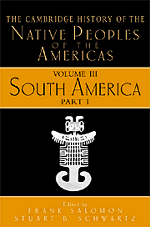Book contents
- Frontmatter
- Contents
- List of Illustrations
- Introduction
- 1 Testimonies: The Making and Reading of Native South American Historical Sources
- 2 Ethnography in South America: The First Two Hundred Years
- 3 The Earliest South American Lifeways
- 4 The Maritime, Highland, Forest Dynamic and the Origins of Complex Culture
- 5 The Evolution of Andean Diversity: Regional Formations (500 B.C.E.–C.E. 600)
- 6 Andean Urbanism and Statecraft (c.E. 550–1450)
- 7 Chiefdoms: The Prevalence and Persistence of “Señoríos Naturales” 1400 to European Conquest
- 8 Archaeology of the Caribbean Region
- 9 Prehistory of the Southern Cone
- 10 The Fourfold Domain: Inka Power and Its Social Foundations
- 11 The Crises and Transformations of Invaded Societies: The Caribbean (1492–1580)
- 12 The Crises and Transformations of Invaded Societies: Andean Area (1500–1580)
- 13 The Crises and Transformations of Invaded Societies: Coastal Brazil in the Sixteenth Century
- Index
5 - The Evolution of Andean Diversity: Regional Formations (500 B.C.E.–C.E. 600)
Published online by Cambridge University Press: 28 March 2008
- Frontmatter
- Contents
- List of Illustrations
- Introduction
- 1 Testimonies: The Making and Reading of Native South American Historical Sources
- 2 Ethnography in South America: The First Two Hundred Years
- 3 The Earliest South American Lifeways
- 4 The Maritime, Highland, Forest Dynamic and the Origins of Complex Culture
- 5 The Evolution of Andean Diversity: Regional Formations (500 B.C.E.–C.E. 600)
- 6 Andean Urbanism and Statecraft (c.E. 550–1450)
- 7 Chiefdoms: The Prevalence and Persistence of “Señoríos Naturales” 1400 to European Conquest
- 8 Archaeology of the Caribbean Region
- 9 Prehistory of the Southern Cone
- 10 The Fourfold Domain: Inka Power and Its Social Foundations
- 11 The Crises and Transformations of Invaded Societies: The Caribbean (1492–1580)
- 12 The Crises and Transformations of Invaded Societies: Andean Area (1500–1580)
- 13 The Crises and Transformations of Invaded Societies: Coastal Brazil in the Sixteenth Century
- Index
Summary
This chapter focuses on complex regional cultures that emerged on the coast and in the highlands of northwestern South America, from what is now southern Colombia through Ecuador and Peru to the Peru-Bolivian high plains (altiplano). In chronology it extends from the latter part of the first millennium B.C.E. to the seventh century C.E. For much of Peru, the beginning and end of this period are marked, respectively, by the spread of Chavín and Wari “horizon styles.” “Horizons” are homogeneous styles that rapidly expanded over large areas.
Andean prehistory is commonly seen in terms of alternating periods of horizontal or interregional integration (i.e., religious movement or empire building) and of regional diversity. In terms of this perception, we are concerned here with cultures dating to the first era of integration (the “Early Horizon”) and the following era of regional diversity. Cultures covered include: Chavín, which is associated with the Early Horizon, Paracas and Nasca on the arid south coast, Lima (also known as Maranga) on the central coast, Vicús (or Sechura), Salinar, Gallinazo (or Virú), and Mochica (or Moche) on the northern coast, Layzón, Cajamarca, and Recuay in the intermontane basins of the North Highlands, all in Peru; La Tolita, Jama-Coaque, Bahía, Guangala, and Jambeli on lush to semiarid coastal Ecuador, and Pukara (also often written Pucara) and Tiwanaku (or Tiahuanaco) in the altiplano or extensive, high plateau grassland around Lake Titicaca (the highest freshwater lake in the world at about 3,810 meters above sea level; Map 5.1; Table 5.1). Such cultures were variously called Mastercraftsmen, Florescent, or Classic cultures based on their material achievements, including construction of monumental adobe mounds, and the artistic and technical excellence of their metal objects, textiles, and ceramics. In this chapter, we adopt the designation “Early Regional Development” (hereafter ERD) culture, as it describes the regional character of the cultures under study without attaching undue subjective value or evolutionary implications to them.
The chapter begins by identifying a number of major biases and limitations of the available data and perspectives and by discussing their effects on the culture synthesis offered in a subsequent section. The chapter then presents a broad-stroke characterization of their natural settings and subsistence bases and strategies, emphasizing creative management of environmental potentials and limitations. The bulk of the chapter characterizes the major material, organizational, and ideological features of selected cultures. Their developmental processes and positions in the long-term trajectory of the Andean civilization are also discussed.
- Type
- Chapter
- Information
- The Cambridge History of the Native Peoples of the Americas , pp. 350 - 517Publisher: Cambridge University PressPrint publication year: 1999
- 15
- Cited by



